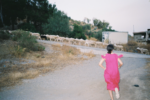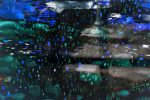Gravitating to the art to talk with it
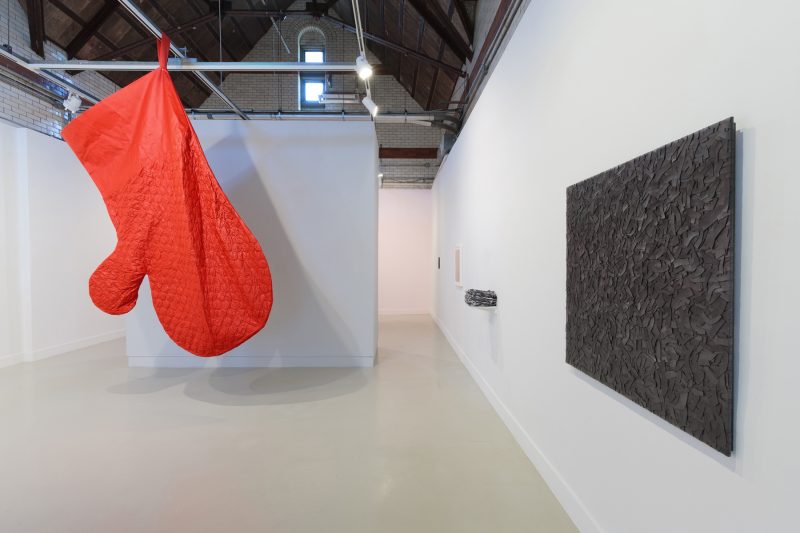
Usually, people are drawn into a conversation by proximity. You walk towards a person, even a stranger, with an open and engaging look on your face and the human response is not flight but talk. You talk. They talk. In Bowlby’s installation, the pieces court your conversational input. You must gravitate to them but when you do, they’re ready to engage.
This show solicits your conversation directly in 3 pieces, but look around the room and there are words everywhere, and you can pick up the conversational thread just by reading and responding.
Three overt conversation starters
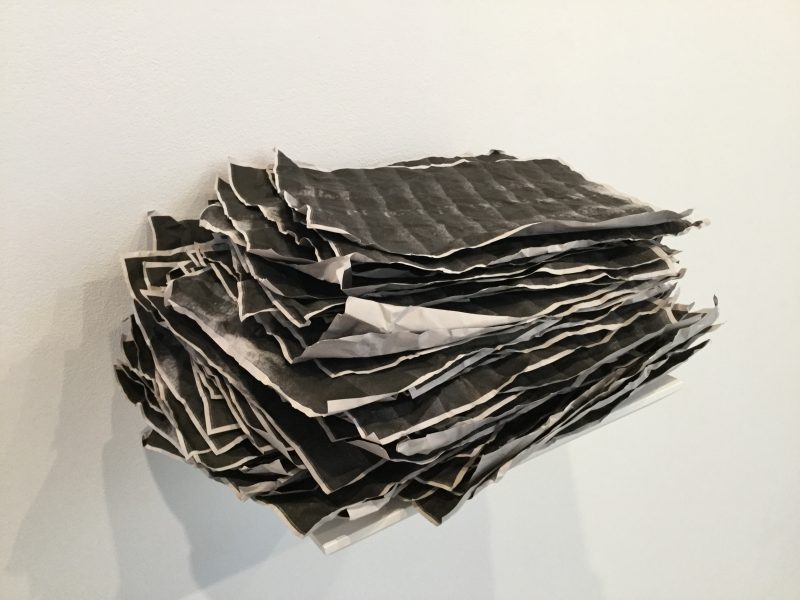
There are two take-away pieces. Are you going to take them? Do you want them? What will you do with them? Are they art? This is a conversation you can have when walking up to the shelf with the pile of shiny green buttons that say “You kill it, you eat it.” Or, when walking towards the stack of crumpled and uncrumpled photocopies called “In Pursuit of Magic,” which hovers (not magically but looks like it from afar) above the floor midway in the room, you will ask yourself: Do I want this? What is it? What do I do with it? While I did not take the button, I did take the crumpled dark paper, crumpled by the artist, uncrumpled by the artist, which spoke to me of the lifelong cycles of birth/death/renewal and anger/frustration/redemption. It called to me and I grabbed it. Although, really, I want the whole pile.
The audio piece, “Blah/me,” also solicits your participation. You are invited to turn on a small cylindrical (and really cute) portable speaker sitting on a shelf on the partition wall. Are you going to turn it on? What will it say to you? When activated, “Blah/me” swells from a single voice speaking to a great cacophony of overlapping voices, which, in the bright acoustics of the gallery, is overwhelming. While interactive, “Blah/me” is actually a monolog, talking at you, and when I saw the show with the artist, who I’ve known for many years and who is a friend, a great talker and writer and teacher, we quickly turned off the noisy piece.
The artist communicator
Astrid Bowlby is a great communicator. Her art is poetic and elliptical and filled with words. Her subject is human-focused concerns and humans. She is a deep carer about people, animals and the planet. The works are made with great attention to detail, almost unbelievably labor intensive. They are made with intelligence and love, ambition, and desire. There are not always words, but in this show words are everywhere, inescapable. It’s not always obvious what the words say or what they mean but the conversation you have with her pieces — and with her — is highly worth having, will make you smile, could be life changing.
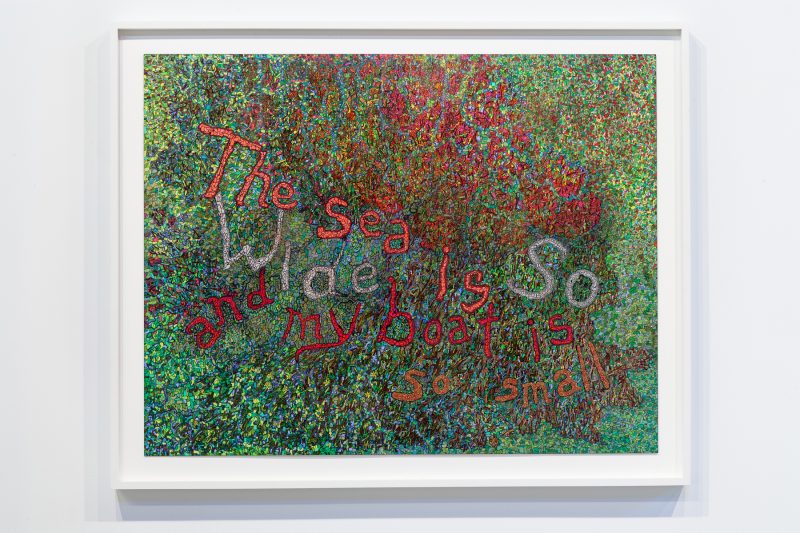
The work “The sea is so wide and my boat is so small,” is an example of the artist’s almost extreme attention to detail and poetic use of words. The words of the title roll across a glittery, colorful background made of thousands and thousands of tiny, hand-drawn objects (flowers, kitchen utensils, stars, and things more abstract). Each object is colored in carefully so that the edges are not covered up. The tiny drawn objects are a dense background like a petri dish filed to the brim with amoeba, although these are very beautiful. Both microscopic and cosmic arrays are suggested. The easel-size work is a mix of tight control and message that signals complete lack of control. Now that’s a conversation.
With 15 works in the beautiful, high-ceilinged gallery, the show is spare. The works are mostly grisaille with a few color touches and range from drawings, mixed media (there’s glitter!), giveaways and a huge red sculpture to an enormous wall piece (144” x 304”) that is words stenciled in pencil onto a pale pink painted wall.
Two tones in the show – lyrical and comic and elegiac
In front of the petition wall, the work mostly is lyrical with a slight comic edge. The big red oven mitt evokes Claes Oldenburg’s public art (The Clothespin). “Oven Mitt” could be a weapon, a pelt, a flag (but not of surrender) or a theatrical prop before which a domestic-themed version of Waiting for Godot might be produced. Adjacent to “Oven Mitt,” the pile of dark take-away papers is like a stack of burned toast or pancakes — it signals failures but it’s comical, too, and the “ongoing project” as the piece is described, suggests both Sisyphus and his endless journey and an indomitable will to succeed.
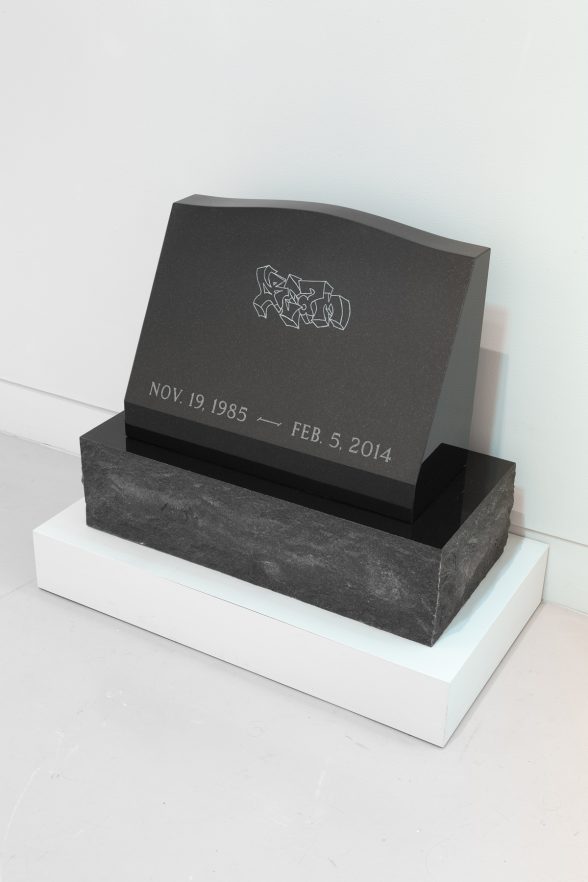
Behind the partition wall the tone is elegiac. There is an actual polished granite grave marker, “Alternative Marker,” with a grafitti tag engraved in place of a name and birth and death dates (1985-2014). Someone died tragically young. The marker will be moved to a meditation garden, we are told. It’s hard to be chipper when faced with the news communicated by this beautiful object. Other works beyond the partition evoke a ghost and a monster screaming. And then there’s the pale pink graphite-on-wall work, whose mantra-like splay of words is, like the audio piece “Blah/me,” a monolog coming at you. Only this one is personal, all about you. “You would not say that to me if I were not, I would not say that to you if you were not,…” and so it goes, an accusation that might just end a conversation while meaning to start one.
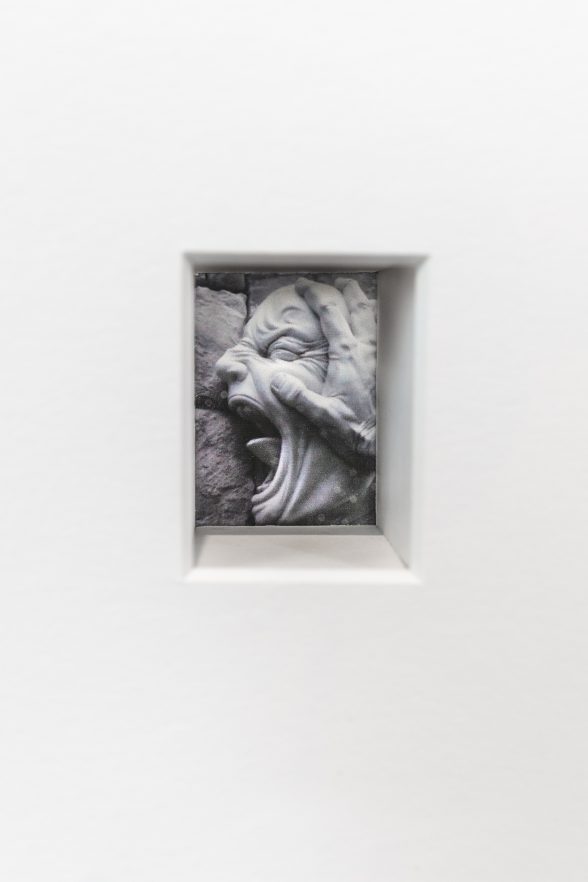
“When the shadow is not your shadow” is a wonderful installation of work by an artist who thinks deeply, cares deeply about people and loves to make art and communicate. The themes are in part highly personal, but they are universal as well — death, love, acceptance, loss, fear, redemption. It’s all in there. Astrid Bowlby will be giving a gallery talk on Sat. Oct. 28, at 2 PM. You should really go, because the conversation should be had, and the artist and her works want to have it. And the show’s last day is Sunday, Oct. 29. Don’t miss it.
Astrid Bowlby “When the shadow is not your shadow,” up to Oct. 29, 2017. Arcadia University Art Gallery, 450 S. Easton Rd., Glenside PA 19038 The show was curated by Marginal Utility’s David Dempewolf and Yuka Yokayama. See more works by Astrid Bowlby at Gallery Joe. See my piece about Astrid’s 2011 installation at the Michener Museum for a very different-looking piece of work.




